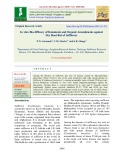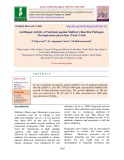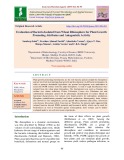
Macrophomina phaseolina in vitro
-
Groundnut (Arachis hypogaea L.) is a cultivated annually belonging to the plant family Leguminosae and sub family Papillionaceae. In groundnut several soil borne disease is occurred. Among them dry root rot is major which caused by Macrophomina phaseolina (Tassi) Goid has been having worldwide importance devastating disease causes severe losses in yield. Invitro, the effectively colony growth of fungus M. phaseolina was inhibited through different bioagent.
 7p
7p  chauchaungayxua12
chauchaungayxua12
 29-07-2021
29-07-2021
 15
15
 1
1
 Download
Download
-
Different non systemic and systemic fungicides are tested at four concentrations under in vitro over Macrophomina phaseolina causing charcoal rot of soybean. Among seven non systemic fungicides, mancozeb 75% WP and propineb 70% WP were found to be the most effective fungicides with cent per cent mean mycelial inhibition at all concentrations (1000, 1500, 2000 and 2500 ppm) tested.
 9p
9p  chauchaungayxua10
chauchaungayxua10
 19-03-2021
19-03-2021
 14
14
 2
2
 Download
Download
-
The antagonistic efficacy of five different bio-agents viz., Trichoderma viride, Trichoderma harzianum, Trichoderma longibrachiatum, Pseudomonas fluorescens and Bacillus subtilis was tested against 25 isolates of Macrophomina phaseolina causing castor root rot by dual culture techniques under in vitro conditions.
 5p
5p  trinhthamhodang9
trinhthamhodang9
 16-12-2020
16-12-2020
 11
11
 2
2
 Download
Download
-
The cluster bean (Cyamopsis tetragonoloba L.Taub.) also known as Guar is one of the most important commercial crop and major source of guar gum. The clusterbean is affected by various fungal diseases. Among those dry root rot caused by Macrophomina phaseolina (Tassi) Goid., a soil borne, cosmopolitan fungus infecting cluster bean and more than 500 plant species. The first symptom of disease is yellowing of the leaves, dark lesion may be seen on the bark at the ground level, the basal stem & main root may show dry rot symptoms.
 12p
12p  trinhthamhodang9
trinhthamhodang9
 16-12-2020
16-12-2020
 18
18
 2
2
 Download
Download
-
Sesame (Sesamum indicum L.) is aprimitive oilseed crops cultivated in semi-arid Tropics and sub tropics regions in India. Macrophomina phaseolina a soil borne fungus cause root and stem rot in sesame crop and pathogen attacks plant at all growth stages. Due to soil borne nature practically no effective field control and no source of resistant is available. A field experiment was conducted with twenty cultivars of sesame during kharif sesame 2017.
 7p
7p  trinhthamhodang1216
trinhthamhodang1216
 19-11-2020
19-11-2020
 10
10
 1
1
 Download
Download
-
Chemical control is one of the measures to manage the disease and avoid the losses. The evaluation study was therefore conducted in vitro. Ten fungicides were tested against the pathogen i.e. Macrophomina phaseolina in vitro. The highest inhibition (100%) of M. phaseolina was observed due to carbendazim 50% WP at different concentration (250, 500, 1000 ppm), mancozeb 75% WP (1500, 2000, 2500 ppm), ridomil-MZ 72% WP (1000, 1500, 2000 ppm) and carbendazim 12% + mancozeb 63% (1500, 2000, 2500 ppm) followed by propiconazole at 250 ppm (87.21 %), 500 ppm (89.92 %) and 1000 ppm (92.
 4p
4p  nguathienthan8
nguathienthan8
 20-10-2020
20-10-2020
 9
9
 2
2
 Download
Download
-
Among the diseases of safflower; dry root rot disease caused by Macrophomina phaseolina (Tassi.) Goid is one of the most destructive and wide spread diseases of Safflower (Carthamous tinctorius L.) causing accountable losses of about 25-60 per cent. A total of ten fungicides namely: Captan, Iprodine, Copper Oxychloride, Thiram Mancozeb, Difenconazole, Propiconazole, Cymoxanil8%+Mancozeb 64%, Carbandazim, & Metalaxyl 8% + Mancozeb 64% were evaluated in vitro against Macrophomina phaseolina.
 13p
13p  trinhthamhodang1215
trinhthamhodang1215
 23-09-2020
23-09-2020
 7
7
 2
2
 Download
Download
-
The present study was carried to evaluate the efficacy of various plant extracts and bio-agents against Macrophomina phaseolina. It is a devastating disease in green gram growing area of Rajasthan. In vitro evaluation of bio-agents and seven plants extract (Datura stramonium, Allium sativum, Zingiber officinalis, Lepticium sparticum, Azadirachta indica, NSKE and Allium cepa), revealed that maximum growth inhibition of Macrophomina phaseolina was recorded in Allium sativum followed by Zingiber officinalis at 5%, 10% and 15% concentrations. Among the concentrations 15 % was most effective.
 8p
8p  nguaconbaynhay7
nguaconbaynhay7
 15-08-2020
15-08-2020
 11
11
 1
1
 Download
Download
-
Chickpea (Cicer arietinum L.) is one of the major legume pulse crops and it is majorly grown in India and other semi-arid regions of the world. Dry root rot of chickpea is the most destructive disease of chickpea. Therefore, in present studies fungicides (six systemic, seven non systemic and six ready mix fungicides) were tested in vitro at three different concentrations by poisoned food technique for evaluating their efficacy against M. phaseolina.
 11p
11p  nguaconbaynhay7
nguaconbaynhay7
 15-08-2020
15-08-2020
 12
12
 1
1
 Download
Download
-
Six fungicides viz., Tebuconazole + Trifloxystrobin 75 WG (Nativo), Hexaconazole 5% + Captan 70 % WP (Taqat), Carboxin 37.5% + Thiram 37.5% WP (Vitavax power), Iprovalicarb 5.5% + Propineb 61.25%WP (Melody duo), Carbendazim 50WP (Hycarb), Mancozeb 63% W.P. + Carbendazim 12% WP (Top too) were evaluated in vitro to test their efficacy against Macrophomina phaseolina by poisoned food technique. Results revealed that all the fungicides were effective in inhibiting mycelial growth of M. phaseolina to varying degrees.
 7p
7p  angicungduoc6
angicungduoc6
 22-07-2020
22-07-2020
 7
7
 1
1
 Download
Download
-
Root rot of soybean is an important disease of soybean inflicting heavy losses in crop. The present investigation was carried out to test the efficacy of agrochemicals and fertilizers in vitro. In bioassay test of non systemic fungicides, Zineb 75 WP gave cent per cent inhibition of growth and sclerotial formation at minimum concentration of 500 ppm followed by copper hydroxide 77WP (53.63%).
 8p
8p  angicungduoc6
angicungduoc6
 22-07-2020
22-07-2020
 4
4
 1
1
 Download
Download
-
Effect of eight antagonists viz., Trichoderma atroviride, T. harzianum, T. virens, T. fasciculatum, T. asperellum, T. viride, Pseudomonas fluorescens and Bacillus subtilis were studied for their antagonism against Macrophomina phaseolina by dual culture method and six fungicides viz. Azoxystrobin 23 SC, Carbendazim (12%) + Mancozeb (63%) 75 WP, Carbendazim (25%) + Mancozeb (50%) 75 WS were evaluated at two different concentrations (500 ppm and 1000 ppm) by poisoned food technique against the same pathogen.
 7p
7p  quenchua6
quenchua6
 15-06-2020
15-06-2020
 9
9
 2
2
 Download
Download
-
Among the diseases of safflower; dry root rot disease caused by Macrophomina phaseolina (Tassi.) Goid is one of the most destructive and wide spread disease of Safflower (Carthamous tinctorius L.) causing accountable losses of about 25-60 per cent. Eleven Botanicals evaluated in vitro were found fungistatic/antifungal against M. phaseolina. Amongs these A. sativum followed by A. cepa and V. negundo caused significantly highest mean mycelial inhibition 83.57, 72.09 and 65.85 per cent respectively.
 15p
15p  gaocaolon5
gaocaolon5
 14-06-2020
14-06-2020
 10
10
 2
2
 Download
Download
-
In recent years Macrophomina phaseolina causing stem canker of pigeonpea is more problematic in pigeonpea growing parts of Karnataka. Present investigation was taken on evaluation of non-systemic, systemic fungicides and bio-agents against M. phaseolina under laboratory condition. Five non systemic, four non systemic and three combi products were evaluated. Similarly two isolates of Trichoderma spp. four Pseudomonas fluorescens isolates, one Pseudomonas putida and one Bacillus subtilis were evaluated against M. phaseolina by poison food technique and dual culture method respectively.
 9p
9p  trinhthamhodang4
trinhthamhodang4
 22-03-2020
22-03-2020
 30
30
 1
1
 Download
Download
-
The effects of different culture media and temperature on mycelial growth and sclerotial formation of Macrophomina phaseolina (Tassi) Goid inciting agent of castor root rot were studied in vitro. Eight different solid and liquid media were tested for their effect on mycelial growth and sclerotial formation of test fungus. Among the solid media, potato dextrose agar (90.00 mm) and Richard's agar (87.71 cm) were the best for fungus growth as well as for sclerotial formation followed by Elliott's medium (80.08 cm).
 5p
5p  cothumenhmong4
cothumenhmong4
 25-03-2020
25-03-2020
 16
16
 1
1
 Download
Download
-
Thirty fungal endophytic isolates were recovered from leaf, stem, root and inflorescence of mulberry plant and the morphological characterization was done. The antifungal potential of isolated mycoendophytes against Macrophomina phaseolina was evaluated in vitro by dual culture technique and revealed that ENF20 isolate reduced the mycelial growth by 82.22 per cent over control followed by ENF12 (80.56 per cent), ENF11 (77.78 per cent), ENF13 (76.11 per cent).
 12p
12p  cothumenhmong3
cothumenhmong3
 22-02-2020
22-02-2020
 18
18
 1
1
 Download
Download
-
In vitro evaluation of nutrients against mulberry root rot pathogen indicated that the ZnSO4 at 250, 500, 750 and 1000 ppm concentration inhibited the growth of Macrophomina phaseolina. The growth inhibition of 100 per cent was observed at 24, 48 and 72 h after inoculation in 1000 ppm concentration of ZnSO4.
 9p
9p  trinhthamhodang3
trinhthamhodang3
 14-02-2020
14-02-2020
 6
6
 1
1
 Download
Download
-
Plant growth promoting rhizobacteria are the soil bacteria present around the rhizopshere and are involved in promoting plant growth and development via different mechanisms. In order to promote sustainable agriculture, the present investigations were undertaken to screen the PGPR isolates from the plant rhizosphere. A total of eight rhizobacteria were isolated from the wheat plant rhizosphere.
 10p
10p  kethamoi2
kethamoi2
 14-12-2019
14-12-2019
 19
19
 0
0
 Download
Download
CHỦ ĐỀ BẠN MUỐN TÌM










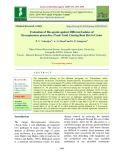
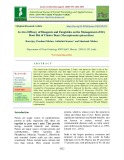
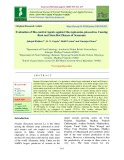
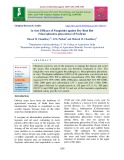

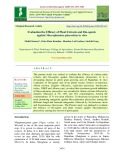
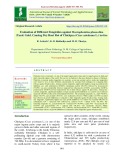

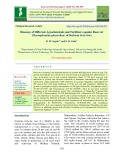
![Evaluation of antagonistic potential of biocontrol agents against Macrophomina phaseolina (tassi) goid. causing stem and root rot of sesame [Sesamum Indicum l.] under in vitro and in vivo Evaluation of antagonistic potential of biocontrol agents against Macrophomina phaseolina (tassi) goid. causing stem and root rot of sesame [Sesamum Indicum l.] under in vitro and in vivo](https://tailieu.vn/image/document/thumbnail/2020/20200615/quenchua6/135x160/7171592231791.jpg)
